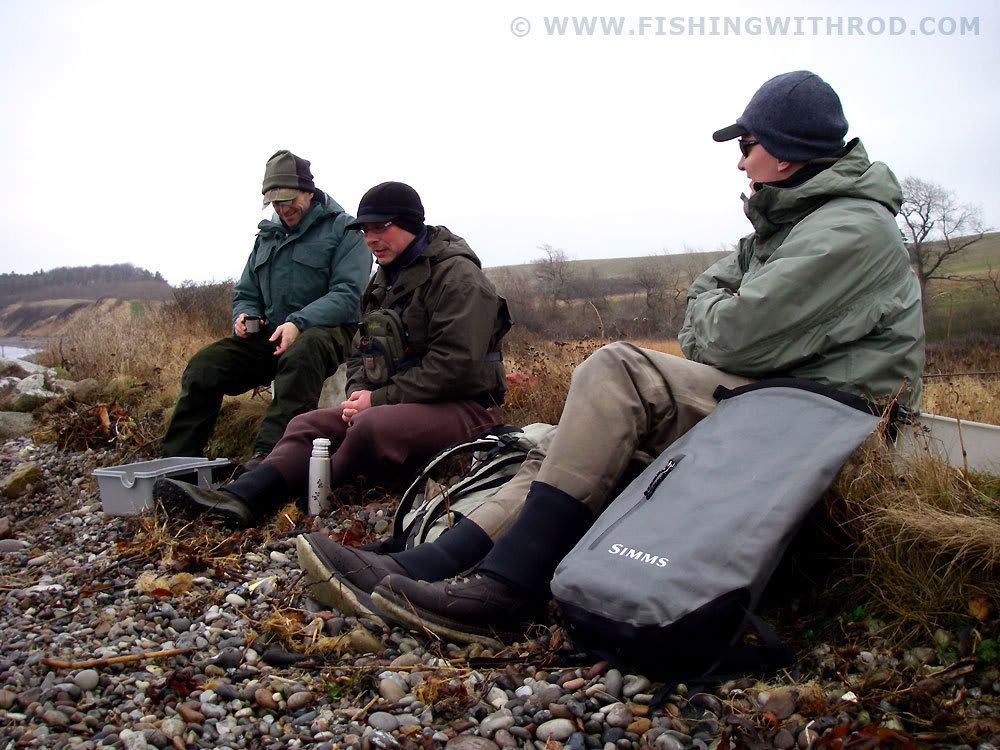Sunday January 6th marked the second 2008 fishing outing and my 6th Danish outing since my arrival several weeks ago. As usual, the
FFFD gang picked me up at the doorstep just after first light. Such convenient service is really appreciated in a foreign country when you do not have vehicle access most of the time. We made our way to another favorite spot of theirs just one hour drive from Copenhagen.
Finally witnessing a beached fish on New Year Day has lifted my spirit and confidence. Perhaps there is a hope after all. The boys began joking about not being able to connect me with some fish so far, since apparently “the fishing has been fantastic here every year, you should have been here.” Perhaps this is one big practical joke that the Danes are playing on a Canadian fisherman? “Rod, there are only so few fish left in Denmark, so we have actually been taking you to all the spots that don’t have fish and save the rest of the fish for ourselves.”, Lars jokingly remarked when we arrived at
the spot.
It was yet another lovely location. The elevated green field behind the beach provided a breathtaking lookout as we made our way down. A couple of farm houses gave me some good photographic opportunities.

The locals must be baffled everytime when I started snapping photos of their houses. Why on earth is this oriental man so fascinated with buildings? The truth is that you simply do not see structures like these in Canada, where we are so accommodated to tearing down poorly built housings after a couple of decades so we could erect bigger poorly built housings. Most of the houses here are several decades old, if not centuries, so each one has its own charm.
The four of us split up once we reached the beach and covered a large stretch of waters. An hour later, Jerk reported one rainbow trout being hooked, while Lars also spotted a couple of rainbow trout milling about. Svend and I got some fresh air.
Rainbow trout? You would think fjords of Denmark are the last places where these North American natives would be found. These are actually escapees from nearby trout farms. Just like Atlantic salmon farms on the coast of British Columbia, these escaped trout can be a problem. Invasive species are never good news. Beside transmitting diseases, predating and competing with native species, they can really spoil the fishing experience (kind of ironic coming from an angler who has been desperately trying to barb a fish in the last few weeks). Frankly, I believe the quality of a fishing location should be judged by how natural the resource is, otherwise it would be like fishing in a giant aquarium. The Great Lakes is a prime example of such ecological disasters. While British Columbia can be considered as the last natural wonderland, illegal introduction of Atlantic salmon, bass and northern pike could put an end to it without interventions.

We decided to make a move. Again, Jerk jokingly remarked, “Now that we have hooked a fish and know there are fish here, we need to move to keep the fish away from you.” I guess that’s what happens when your guides are not being paid.
The second beach was even longer than the first one. Once again we split up to cover all the spots. Lars took off so far until we could not see him. One has to wonder what was in the coffee to get a such a boost of energy in this harsh Nordic winter.
Today I decided to give a technique commonly used by local beach anglers. They are called Bombarda floats, which are weighted but carefully balanced so it provides good casting distance as well as a controlled sink. These are typically used by spin fishermen who wish to fish with a fly at times. The sliding float is threaded onto the main line, which is tied onto a swivel. A leader up to 8 feet is tied on, followed by the fly.

The floats come in different weights (10, 15, 20, 25, 30 grams) and different densities (float, intermediate, sinking). On any given day, these could be advantageous as they allow the anglers to cover their waters with a fly much more efficiently. For pseudo-flyfishermen such as myself, who can barely reach 40 feet without hitting the back of my head, these are really handy.
My first taste of the presence of fish came around one hour after covering a stretch of weedbed. When my fly reached the shallows during one retrieve, I briefly spotted one fish following behind it. Perhaps it also spotted me, because it turned around, made a swirl and darted away immediately. Excited, I quickly attempted another cast, but I had forgotten to open the bail on the spinning reel so all I could watch was my Bombarda float flying away like an egg after the dreadful snap. Good thing no one around me saw that.
I then decided to give the trusty metal lure a try. Svend stood nearby and watched, probably wondering why I was spending so much time at one spot. Within a couple of casts, I felt a distinct bite and set the hook. The fish made a couple of kicks on my rod and freed itself before I even had a chance to scream, “Fish on!”
That pretty much sums up another beach outing in Denmark, with a couple of brief encounters. Disappointed? Absolutely not, since each trip has allowed me to absorb local knowledge and fine-tune the techniques. A hook-up also suggests this might not be a conspiracy created by the Danes to hide their fish from this Canadian after all.
Of course, we cannot finish this entry without yet another beach shot.


 Author
Topic: 2007/2008 winter Danish journal (Read 20568 times)
Author
Topic: 2007/2008 winter Danish journal (Read 20568 times)

